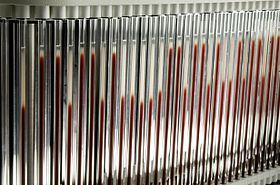Erythrocyte Sedimentation Rate
| Erythrocyte sedimentation rate | |
|---|---|
| Medical diagnostics | |

Westergren pipet array on StaRRsed automated ESR analyzer
|
|
| Synonyms | sedimentation rate, Westergren ESR |
The erythrocyte sedimentation rate (ESR) is the rate at which red blood cells sediment in a period of one hour. It is a common hematology test, and is a non-specific measure of inflammation. To perform the test, anticoagulated blood was traditionally placed in an upright tube, known as a Westergren tube, and the rate at which the red blood cells fall was measured and reported in mm/h.
Since the introduction of automated analyzers into the clinical laboratory, the ESR test has been automatically performed.
The ESR is governed by the balance between pro-sedimentation factors, mainly fibrinogen, and those factors resisting sedimentation, namely the negative charge of the erythrocytes (zeta potential). When an inflammatory process is present, the high proportion of fibrinogen in the blood causes red blood cells to stick to each other. The red cells form stacks called 'rouleaux,' which settle faster, due to their increased density. Rouleaux formation can also occur in association with some lymphoproliferative disorders in which one or more immunoglobulins are secreted in high amounts. Rouleaux formation can, however, be a normal physiological finding in horses, cats, and pigs.
The ESR is increased in inflammation, pregnancy, anemia, autoimmune disorders (such as rheumatoid arthritis and lupus), infections, some kidney diseases and some cancers (such as lymphoma and multiple myeloma). The ESR is decreased in polycythemia, hyperviscosity, sickle cell anemia, leukemia, low plasma protein (due to liver or kidney disease) and congestive heart failure. The basal ESR is slightly higher in females.
...
Wikipedia
